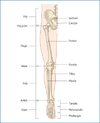A small information about our leg...
A leg is a weight-bearing and locomotive anatomical structure, usually having a columnar shape. During locomotion, legs function as "extensible struts". The combination of movements at all joints can be modeled as a single, linear element capable of changing length and rotating about an omnidirectional "hip" joint.
You have many different muscles in your upper and lower leg. Together, these muscles help you walk, run, jump, stand on your toes and flex your feet (lift your toes up toward your knee). Your leg muscles work with your bones, tendons and ligaments to stabilize your body, support your weight and help you move

A leg is a weight-bearing and locomotive anatomical structure, usually having a columnar shape. During locomotion, legs function as "extensible struts". The combination of movements at all joints can be modeled as a single, linear element capable of changing length and rotating about an omnidirectional "hip" joint.
You have many different muscles in your upper and lower leg. Together, these muscles help you walk, run, jump, stand on your toes and flex your feet (lift your toes up toward your knee). Your leg muscles work with your bones, tendons and ligaments to stabilize your body, support your weight and help you move







